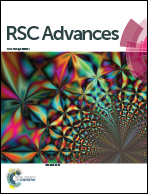A sensitive dopamine biosensor based on ultra-thin polypyrrole nanosheets decorated with Pt nanoparticles†
Abstract
A sensitive and selective electrochemical sensor to determine dopamine (DA) was successfully fabricated from ultra-thin polypyrrole nanosheets (UltraPPy) that were decorated with Pt nanoparticles (Pt/UltraPPy–GCE). The morphology and structure of the modified electrode were characterized using transmission electron microscopy (TEM), atomic force microscopy (AFM), X-ray diffraction and Fourier-transform infrared spectroscopy (FTIR). This new electrode displayed a synergistic effect of UltraPPy and Pt on the electro-oxidation of DA in phosphate buffer solution at pH 7. The Pt/UltraPPy–GCE demonstrated excellent electrochemical activity towards DA oxidation compared with the bare GCE, UltraPPy–GCE and Pt NPs–GCE, possibly because of the larger surface area of the UltraPPy, which increased the interactions between the polymer and the K2PtCl4 solution during Pt NP deposition. The small size of the deposited Pt NPs resulted in a large surface area of Pt, which is suitable for the reaction with DA. Furthermore, polypyrrole (PPy) in the nanocomposite material could crosslink to improve its stability with the Pt NPs. By applying the differential pulse voltammetry technique under optimized experimental conditions, a good linear ratio of oxidation peak currents and DA concentrations over a range of 0.01–400 μM was achieved with a limit of detection of 0.67 nM. This electrode was used to determine the DA concentration in a DA hydrochloride injection.


 Please wait while we load your content...
Please wait while we load your content...